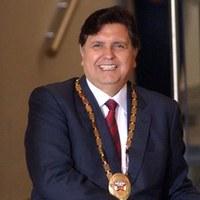Lima (Peru), 1949
By Heraclio Bonilla
After completing secondary studies at the José Maria Eguren School in Barranco, García studied law at PUCP (Pontifical Catholic University of Peru), earning his doctorate at the Complutense University of Madrid. He completed his postgraduate studies in Paris under the guidance of the eminent Peruvianist François Bourricaud. Alan García, who had joined the ranks of the Peruvian Aprista Party at just seventeen years old, returned to Peru under pressure from Victor Raúl Haya de la Torre, the party’s founder, and was elected in 1979 as a member of the Constituent Assembly; in 1982, he assumed the party’s general secretary position. These were the foundations of a meteoric political career that culminated in his election as president in 1985.
In the 1985 elections, the young and charismatic leader Alan García Pérez, considered the protégé of Haya de la Torre but with an unquestionable family tradition in the American Popular Revolutionary Alliance (APRA), received 45% of the total votes cast, a share that reached 53% when counting only valid votes. The victory was so overwhelming that his closest opponent, Alfonso Barrantes Lingán, head of the United Left coalition, declined to participate in the runoff, as required by the electoral system at the time. Neither the APRA of 1985 was still the party of the catacombs, nor was it clear whether voters preferred APRA or the impassioned Alan García.
His government, between 1985 and 1990, unfolded in two very different phases. The first, marked by euphoria and growth, was driven by the leader’s vehemence and the implementation of an economic policy characterized by heterodoxy and the full utilization of the productive capacity of an economy stagnated by previous crises. The second phase, starting in 1987, was expressed through chaos and anarchy as a consequence of the exhaustion of this model, the absence of corrective mechanisms, international pressures and betrayals, and multiple and contradictory promises made under irresponsible populism. By the end of his government, inflation had reached a record figure of 7,500%, while production had decreased by 6%.
Nevertheless, it was a leadership and government that sparked curiosity and expectations throughout the hemisphere for adopting unusual measures during those years. Among them, notable was his proposal to limit the payment of external debt to a fraction of foreign trade revenues, 10%, so as not to affect the welfare of the people; in response to growing subversion pressure, the allocation of resources to the most vulnerable regions and populations of the country, those part of the so-called “Andean trapezoid”; the nationalization of the private bank as a way to double capital resistance. This last decision strengthened his adversaries, who unified their interests under the leadership of Mario Vargas Llosa and Fredemo (Democratic Front), the unprecedented direct political translation of the interests of the entire property-owning class and its allies.
There was no doubt about APRA’s support for Alberto Fujimori in the 1990 elections, and García could not avoid the punishment for his boldness and the fall of popular support in the crossfire of inflation, unemployment, and subversion. In 1992, he went into exile, living between Colombia and France until his return to Peru on January 27, 2001, to intervene again in the elections after the fall of Fujimori’s government. Between January and June that year, he managed to reverse a virtually null preference to achieve, in the elections of April 8 and June 1, 25.8% and 47.5%, respectively, of voter preference, against defeated and faltering candidates. The vicissitudes of his government were portrayed in his books El futuro diferente, A la inmensa mayoría: discursos, El desarme financiero, La falsa modernidad, El mundo de Machiavello, La revolución regional, La década infame: deuda externa 1990-1999. He was honorary president of the Socialist International and in the 2006 elections was again elected president of Peru, with 52.6% of the votes.
His government maintained the neoliberal orientation of his predecessor Alejandro Toledo, expanding privileges for transnational companies and continuing the economic model based on extractivism and export of the country’s natural resources. García invested in infrastructure and poverty alleviation programs without significantly altering the economic and social inequality that marks Peru. His administration was tainted by the Bagua massacre in 2009, resulting from a confrontation between police and indigenous people, leaving 34 dead and more than two hundred injured.
García was preparing his candidacy for the 2016 elections, hoping for a third term.



